Holiday to Italy visiting Pompeii, Herculaneum, Vesuvius and the Amalfi Coast
This year we went on holiday to Italy for a week, staying near Naples. There are many wonderful sights in the area, such as Mt. Vesuvius, Pompeii, Herculaneum and the Amalfi Coast. Off the beaten track, the food is cheap and pizza is unlike anywhere else we’ve experienced – which makes sense given it’s the region that invented the stuff!
We arrived on Wednesday 3rd October, and following is a brief day-by-day account.
Day 1 - Arrival §
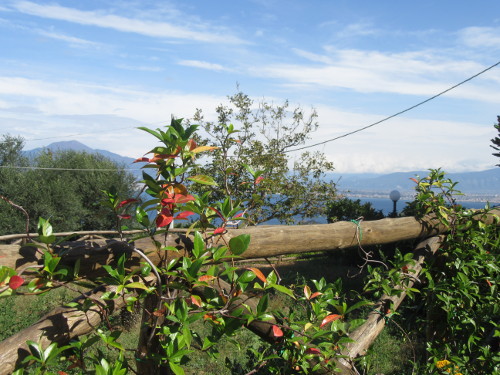
After leaving the airport, we got a free shuttle bus to the car rental area. I’d booked us a Fiat 500 in advance online, and chosen not to pay the steep extra fee to reduce the excess down to zero. Upon collecting the car in person, the attendant highly recommended we pay the extra fee, but again I declined, not wanting to be pushed into paying more unnecessarily.
The moment we drove out the car park and joined the traffic in Naples we started to question that choice. Local cars treated speed limits, lane markings and red lights as suggestions. It seemed every other car had signficant damage – missing wing mirrors, bumpers, or large dents. The constant background churn of car horns soon made us forget the feeling of being startled and alerted one gets hearing just a solitary car horn in England.
On the three-line motorway, four or sometimes five cars would drive side-by-side, almost bumper-to-bumper, with motorcyclists weaving inbetween. The flux of the traffic, though unnerving, was also quite impressive. Unlike on the M25, affectionally known for being the world’s largest car park, traffic here continued to move, drivers regularly changing lanes vying to stay ahead and keep their speed up.
While it was a relief to finally leave the motorway and reach the start of the driveway for our house, the feeling was short-lived as we discovered the driveway was incredibly steep, narrow, had no barrier for the first short section, and concluded with a blind hairpin turn. Even with our Fiat 500 we had to fold the wing mirrors in as a lamp post half-way up took a precious few centimeters away from the width of the road.
Finally we reached the gateway to our property, unscathed, and settled in for the night. The picture above is actually from the following morning, since we arrived late at night. The view from the property was almost spectacular, save for some unfortunately placed telephone poles; it provided a sweeping view across the Bay of Naples, with Mt. Vesuvius in the backdrop.
Day 2 - Herculaneum §
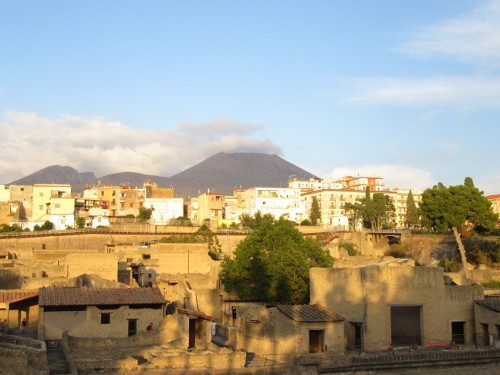
We began our first full day with breakfast outside in the morning sun, followed by a walk for supplies to a nearby local shop. Armed with cash and handful of groceries, our mutual lack of speaking each other’s language was not a problem when it came to paying. Nearby a local church perched at a beautiful vantage point was conducting a wedding ceremony, and the sun was being down through the clear, blue skies.
After breakfast we set out to visit Herculaneum. The drive was less exhausting than the day before, perhaps because we didn’t stray as near to Naples. We parked in an underground car park immediately next to Herculaneum.
Herculaneum itself was extremely impressive. Though small, the buildings were astonishingly well preserved for being 2000 years old, with plentiful mosaics, multiple-storey structures, and even some wooden furniture and doorways. As shown in the photo above, the ancident buildings provide a remarkable juxtaposition against the nearby present-day buildings, with Mt. Vesuvius looming ever-present in the background.
While we were there for less than a whole day, that was enough time to see Herculaneum through. The final path out leads you through what used to be the docks, now a couple of kilometers from the shoreline. There beneath rows of arches are a sombre reminder of the grim reality of the eruption in 79 AD; scores of skeletons, frozen for all time in their final desperate positions.
The path around Herculaneum provides a magnificent view of the excavation, especially as you head up the slope and across a bridge towards town. From there we found a local pizza shop (Pizzeria Luna Caprese Sas Di Luna Michelina) which sold full size pizzas for €5 each. As well as being incredibly cheap, they were the best pizzas we’d ever had. I ordered what was called a “Susanna”, which according to the menu had a topping of “whipped cream” – though we suspect this is a case of a poor “Engrish” translation, and it was perhaps panna cotta. The pizza shop staff didn’t speak any English, but as with the shop owner from that morning, it was not a problem.
Inbetween leaving the Herculaneum excavation and heading for pizza, we had popped back to the car park to check when it was open until, since we didn’t want our car to be locked in overnight. The payment booth was staffed by three Italian men who spoke no English. When we spoke, they quite rightly assumed we were trying to pay, but in fact we were trying to ask when the car park closed. We got Google translate out, and the men were a mixture of impressed and amused by the technology. Nevertheless we came to understand that closing time was not a problem. It was gone 8pm when we returned to the car park to find that the exit was locked, and the men were sat outside smoking and playing cards. They were cheerful to see us, evidently enjoying just relaxing outside in the pleasant evening air. Ours was the last car there, and they instructed us exit through the entrance (since that was not locked). Later I noticed in a very nearby location the Italian men can be seen at their table on Google Street View.
Day 3 - Sorrento §
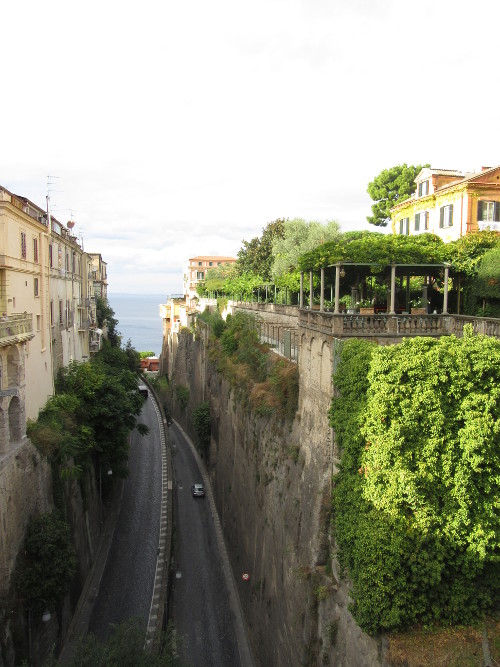
The drive to Sorrento was fraught with mopeds. Just as here in Cambridge many people ride a bicycle in whatever they are wearing – be it heels or a university gown – so too did locals in Sorrento treat mopeds as their primary mode of transport. Given the geography of a steep coastline, there is generally only one main road that follows the countours, and these locals on mopeds don’t have time to wait behind tourists who fail to exceed the speed limit.
We chose a supermarket car park on the outskirts of Sorrento, which left us with a mile or so walk into town. The main square (by day a busy junction, but by night a mostly pedestrian-only zone), provides a stunning view across a gorge, housing a hairpin road that leads to the harbour.
The alleways of Sorrento were chock full of market stalls, restaurants, but most of all: tourists. We ate some wonderful gelato at a highly rated venue, then had dinner at a pleasant restaurant called Blu Water, where the waiters were making good use of their English to try and attract tourists in. With us they were successful, and so were we too it turned out – the price, though much more than the Herculaneum pizza, was decent; and the food was very good.
On our way back to the car, we popped into the supermarket which advertised a 9:00PM closing time. However part way through our shop we were ushered towards the tills, being told by staff that the shop was closing and we had to pay and leave. It was 8:30PM.
On a positive note, the supermarket car park (unlike the rest of Sorrento) had free toilets. Worth knowing!
Day 4 - Rain §
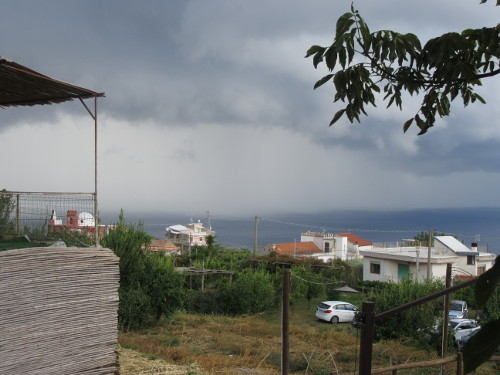
The day began bright and sunny. We walked along the roads up the hill to a nearby local restaurant for lunch. At first we were sat outside in the shade, enjoying the view across the bay, but in the distance ominous thick clouds marched closer and closer. Soon enough it was apparent there was a wall of water headed our way. We sought cover inside, and moments later a torrential downpour began, which did not cease for some time. At a break in the rain we made a run for it, having come without coats, and managed to reach our house before it began again.
Day 5 - Pompeii §
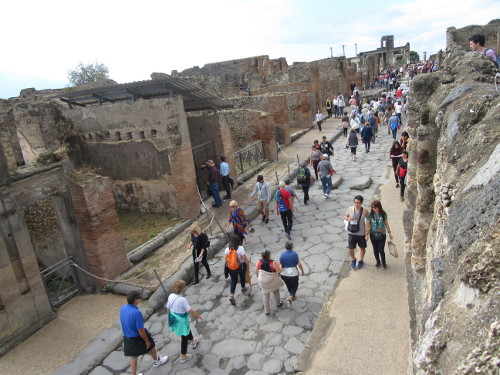
Bright and early we drove over to Pompeii, parking at the nearby Camping Zeus campsite, which is easy to miss being a 180 degree hairpin turn just as you leave the motorway off ramp. The fee rather dear (€3 per hour 7am to 8pm, otherwise €2), but that is perhaps to be expected given the nature of this place. Our timing was fortunate though, as it turns out (like many other popular sites in Europe) Pompeii is free on Sundays. Since there was no entrance fee, we put that money towards buying an audio guide. That turned out to be a very wise investment because there was no written information provided throughout!
Compared to Herculaneum, Pompeii itself is huge – not only just in terms of land coverage, but also in terms of the scale of the of the buildings. While the majority of Pompeii seemed to have only the single storey buildings preserved, several colossal theatres have (with some modern repairs) have survived in their grandeur.
From the central plaza (known as the forum), Pompeii’s story unfolds around you. At the time of the eruption, the city had been undergoing lots of construction and repair work in response to an earthquake several years earlier. Little did they know how futile these repairs were in the face of the oncoming disaster. In several places throughout the vast site are plastercast bodies of the people and animals who fell, constructed by when the archeaologists came across strange voids left by their remains. These bodies were far less numerous than I had anticpiated, but each one was remarkable. Unlike at Herculaneum where only the skeltal structure can be seen, at Pompeii the cast (though rough and jagged) brings the humanity strikingly to life.
While Pompeii goes on and on, the map they provide you with fails to mark that many streets are closed, many blocks have specific opening hours, and some streets have a one-way system and queue enforced. This leads to a rather frustrating experience, as your expectations are gradually whittled down with every “no entry” sign you come across. It would not be an issue if they told you up front, but to only find out about the numerous closures by trekking over yourself is quite disheartening. On the plus side, it is nice to get off the beaten track and explore some of the side streets. The main roads, especially those from the forum and entrances, are astonishgly busy. The photo above provides a glimpse of one of the main streets at a fairly quiet period – when tourists groups on a paid tour come by, the whole street becomes awash with feet. However as a tourist myself, it’s a bit hypocritical to complain about there being too many tourists!
While you could spend more than a day at Pompeii, unless you went out of your way to visit all the various special buildings at their open times, I think you might tire of the sights. When the end of the day approached, while I wanted to make sure I had got the most I could out of the visit before leaving, I also felt like I was nearing my saturation point. Maybe a fresh start with a new day would have provided me with more inspiration and motivation, but since we visited only once I cannot answer that.
Afterwards we ate at the nearby Hortus Porta Marina. It was the easy option, being only a few meters from the West entrance to Pompeii, but surprisingly had good food for a fair price.
All in all I’d say both Herculaneum and Pompeii are definitely worth a visit; Herculaneum for just how well preserved everything is, and Pompeii for the scale of the excavation. But be prepared to battle the crowds at Pompeii, and to encounter many dead-ends if you leave the main streets.
Day 6 - Vesuvius §
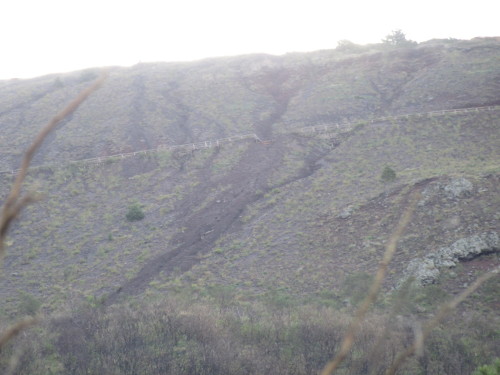
The rain from two days earlier had indeed been torrential. So much so that, as can been seen by the scars in the photo above, the path leading up the volcano had been washed away. As such the mountain was officially closed. While the closure was disppointing, the frustration was compounded by the lack of information provided about the situation. The official Mt. Vesuvius website proudly boasted about how it catered for both Italian and English readers, proving news and updates in both languages. However the mountain closure was only mentioned on the website very briefly, in Italian, and you had to dig through layers of links to find it – rather than displaying such an important message on the front page. While the official Twitter and Instagram accounts for Mt. Vesuvius continued to post photos and articles about why you should visit, none of them mentioned that the mountain was actually closed!
It was unclear whether the mountain would open in a few days, weeks, or months. I spoke to an official at the locked gate where the washed out trail to the crater began, and she assured me I simply needed to check the website for information. Hundreds of other tourists were having the same issue, arriving by the coachful only to find a locked gate and very little real information.
Interestingly the public car park for Mt. Vesuvius is just a very long winding road which follows the contours of the mountainside. It starts at a right-hand fork in the road about a mile before the coach park. Searching online for “Mt. Vesuvius parking” leads to the wrong location – the obvious “car park” is actually a coach park and taxi drop-off point.
Unfortunately Mt. Vesuvius did not re-open while we were still in Italy. I sent a DM to the official Mt. Vesuvius account asking if they could tell me approximately when the mountain would be open again. They replied several days after our holiday had finished simply saying that the mountain is closed.
Perhaps one day we will revisit Mt. Vesuvius, hopefully after a dry spell.
We went back to Sorrento for the afternoon, and ate again at Blu Water.
Day 7 - Amalfi Coast §
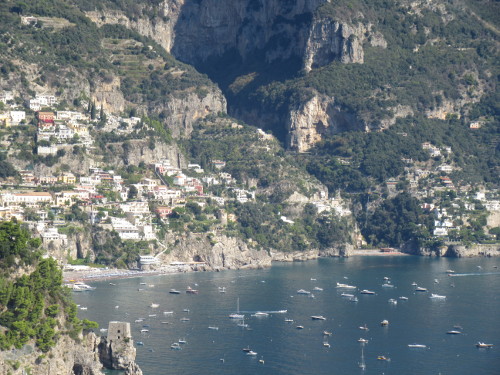
We headed out in the morning along the winding coastal road to Amalfi. The views were spectacular, and there were many view points that we stopped at along the way. With a south-facing hillside and beautiful weather, beaches and sea; it is no wonder this is such a popular location.
The town of Amalfi was, predictibly, very touristy. Perhaps the higlight of the visit was the Paper Museum (Museo della Carta), tucked away at the top of the town, they proudly display and operate the original machinery, still powered by a watermill, though the stream now runs underneath the streets of Amalfi.
We parked in a Bond villain lair - Luna Rossa. Bored into the eastern mountainside, this underground carpark is connected to Amalfi through a pedestrian tunnel, and all passengers are required to exit the vehicle before the driver is allowed to drive the car in. Upon leaving, again only the driver is permitted to go and fetch the car – passengers must wait at the tunnel exit, then quickly jump in to avoid causing a traffic jam.
Day 8 - Sorrento §
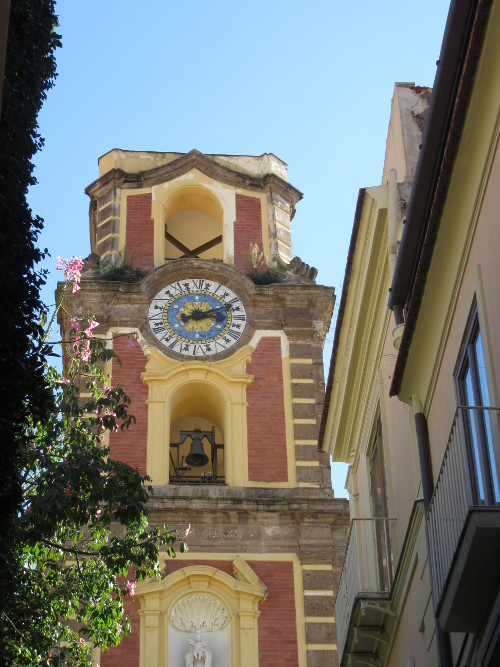
With Mt. Vesuvius still closed, we spent our last full day back again in the familiarity of Sorrento. Took a trip to a local yarn shop on the northern end of Viale Nizza, to make an “Amalfi Coaster”. Ate lunch at the waterside Ristorante Ruccio with a calming view of ships gentling entering and leaving the harbour. Couldn’t resist another trip to the gelato shop before driving over to a different hotel for the last night.
Like an oasis in a desert, Relais Casa Raiola was an elegant walled garden and luxurious hotel surrounded by shabby houses with rubbish bags floating about the pavement. Another night there wouldn’t have gone amiss. The food, service and decor were excellent. Sadly we had only one night at this hotel before our holiday ended.
Day 9 - Herculaneum §
Before heading to the airport, we popped by Herculaneum again, since it was only just round the corner. For some unknown reason the car park we had used before was closed, and Italian police were there helping confused tourists figure out what to do, since on-street parking was disallowed. They instructed us to park in front of the exit gate for the car park, which was closed and locked. We were rather confused by this, and so double-checked to make sure that was what they had meant for us to do. Receiving the affirmative, we left our car parked in front of the gates.
We walked to the nearby MAV - Virtual Archaeological Museum – which according to its website was open. However we arrived to find a conference taking place, so it was closed to the public.
Sticking to what we knew worked, we headed back to the pizza place from the first full day for another €5 pizza.
Upon returning to the car park a couple of hours later we found the gates now open, and the police nowhere to be seen. Fortunately it was now very quiet, and we did not appear to have been obstructing anyone.
The return drive through Naples traffic to the airport was not as bad as the outward journey, and we successfully handed back an unblemished car, keeping our full deposit.
Summary §
If better tourist information was provided, the biggest downsides of the trip would have been eliminated: the unmarked dead ends in Pompeii, the lack of information about Mt. Vesuvius and the “MAV” being closed, and the difficulty in finding out good parking locations before arriving. All that aside, the attractions near Naples are outstanding. Herculaneum and Pompeii offer archaeological sites the scale and quality of which I’ve never seen before, and the winding coastal roads provide unforgettable views. It was a wonderful trip, but I left looking forward to being able to relax at home.